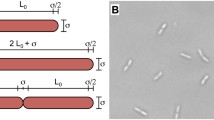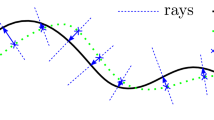Abstract
In this paper, a 3D computational model has been developed to investigate biofilms in a multi-physics framework using smoothed particle hydrodynamics (SPH) based on a continuum approach. Biofilm formation is a complex process in the sense that several physical phenomena are coupled and consequently different time-scales are involved. On one hand, biofilm growth is driven by biological reaction and nutrient diffusion and on the other hand, it is influenced by fluid flow causing biofilm deformation and interface erosion in the context of fluid and deformable solid interaction. The geometrical and numerical complexity arising from these phenomena poses serious complications and challenges in grid-based techniques such as finite element. Here the solution is based on SPH as one of the powerful meshless methods. SPH based computational modeling is quite new in the biological community and the method is uniquely robust in capturing the interface-related processes of biofilm formation such as erosion. The obtained results show a good agreement with experimental and published data which demonstrates that the model is capable of simulating and predicting overall spatial and temporal evolution of biofilm.











Similar content being viewed by others
References
Rittmann BE, McCarty PL (1980) Model of steady-state-biofilm kinetics. Biotechnol Bioeng 22:2343–2357
Wanner GW (1986) A multispecies biofilm model. Biotechnol Bioeng 28(3):314–328
Picioreanu C, Loosdrecht MCM, Heijnen JJ (1999) Discrete-differential modeling of biofilm structure. Water Sci Technol 39:115–122
Picioreanu C, Loosdrecht MCM, Heijnen JJ (2000) Effect of diffusive and convective substrate transport on biofilm structure formation: a two-dimensional modeling study, Biotechnol Bioeng 69:504–515
Picioreanu C, Loosdrecht MCM, Heijnen JJ (2001) Two-dimensional model of biofilm detachment caused by internal stress from liquid flow. Biotechnol Bioeng 72:205–218
Alpkvist E, Klapper I (2007) A multidimensional multispecies continuum model for heterogeneous biofilm development. Bull Math Biol 69:765–789
Dillon R, Fauci L, Fogelson A, Gaver D (1996) Modeling biofilm processes using the immersed boundary method. J Comput Phys 129(1):57–73
Kreft J-U, Booth G (1998) BacSim, a simulator for individual-based modeling of bacterial colony growth. Microbiology 144:3275–3287
Kreft J-U, Picioreanu C (2001) Individual-based modeling of biofilms. Microbiology 147:2897–2912
Kreft J-U, Picioreanu C, Wimpenny JWT (2004) Particle-based multidimensional multispecies biofilm model. Appl Environ Microbiol 70:3024–3040
Tang Y, Valocchi AJ (2013) An improved cellular automaton method to model multispecies biofilms. Water Res 47:5729–5742
Picioreanu C, van Loosdrecht MCM, Heijnen JJ (1998) A new combined differential-discrete cellular automaton approach for biofilm modeling: application for growth in gel beads. Biotechnol Bioeng 57(6):718–731
Noguera DR, Pizarro G, Stahl DA, Rittmann BE (1999) Simulation of multispecies biofilm development in three dimensions. Water Sci Technol 39(7):123–130
Fujikawa H, Matsushita M (1989) Fractal growth of bacillus subtilis on agar plates. J Phys Soc Jpn 58:3875–3878
Picioreanu C, Kreft J-U, Van Loosdrecht MCM (2004) Particle-based multidimensional multispecies biofilm model. Appl Environ Microbiol 70(5):3024–3040
Eberl HJ, Parker DF, Van Loosdrecht MCM (2001) A new deterministic spatio-temporal continuum model for biofilm development. J Theor Med 3:161–175
Lardon LA, Merkey BV, Martins S, D\({\ddot{o}}\)tsch A, Kreft JU, Picioreanu C, Wimpenny JWT, Smets BF (2011) iDynoMiCS: next-generation individual-based modeling of biofilms. Environ Microbiol 13(9):2416–2434
Cumsille P, Asenjo JA, Conca Carlos (2014) A novel model for biofilm growth and its resolution by using the hybrid immersed interface-level set method. Comput Math Appl 67:34–51
Dockery J, Klapper I (2001) Finger formation in biofilm layers. SIAM J Appl Math 62(3):853–869
Cogan N (2008) Two-fluid model of biofilm disinfection. Bull Math Biol 70:800–819
Jones GW, Chapman SJ (2012) Modeling growth in biological materials. SIAM Rev 54(1):52–118
Kroon W, Delhaas T, Arts T, Bovendeerd P (2009) Computational modeling of volumetric soft tissue growth: application to the cardiac left ventricle. Biomech Model Mechanobiol 8:301–309
Kuhl E, Holzapfel GA (2007) A continuum model for remodeling in living structures. J Mater Sci 42:8811–8823
Ambrosi D, Ateshian GA, Arruda EM, Ben M, Amar SC, Cowin J, Dumais A, Goriely GA, Holzapfel JD, Humphrey R, Kemkemer E, Kuhl J, Ma JE, Olberding LA, Taber R Vandiver, Garikipati K (2011) Perspectives on biological growth and remodeling. J Mech Phys Solids 59:863–883
Taber LA (1995) Biomechanics of growth, remodeling and morphogenesis. Appl Mech Rev 48:487–545
Taber LA (1998) A model for aortic growth based on fluid shear and fiber stresses. Trans ASME J Biomech Eng 120:348–354
Bakke R (1986) Biofilm deattachment, PhD thesis, Montana State University
Horn H, Reiff H, Morgenroth E (2003) Simulation of growth and detachment in biofilm systems under defined hydrodynamic conditions. Biotechnol Bioeng 81:607–617
Picioreanu C, van Loosdrecht MCM, Heijnen JJ (2001) Two-dimensionalmodel of biofilm detachment caused by internal stress from liquid flow. Biotechnol Bioeng 72:205–218
Duddu R, Chopp DL, Moran B (2009) A two-dimensional continuum model of biofilm growth incorporating fluid flow and shear stress based detachment. Biotechnol Bioeng 103(1):92–104
Boel M, Moehle RB, Haesner M, Neu TR, Horn H, Krull R (2009) 3D finite element model of biofilm detachment using real biofilm structures from CLSM data. Biotechnol Bioeng 103:177–186
Stoodley P, Lewandowski Z, Boyle JD, Lappin-Scott HM (1998) Oscillation characteristics of biofilm streamers in turbulent flowing water as related to drag and pressure drop. Biotechnol Bioeng 57(5):536–544
Stoodley P, Lewandowski Z, Boyle JD, Lappin-Scott HM (1998a) Structural deformation of bacterial biofilms caused by short-term fluctuations in fluid shear: an in situ investigation of biofilm rheology. Biotechnol Bioeng 65:83–92
Alpkvist E, Klapper I (2007) Description of mechanical response including detachment using a novel particle model of biofilm/flow interaction. Water Sci Technol 55(89):265–273
Zhijie X, Meakin P, Tartakovsky A, Scheibe TD (2011) Dissipative-particle-dynamics model of biofilm growth. Phys Rev E 83:066702
Xavier JD, van Picioreanu C (2005a) A general description of detachment for multidimensional modeling of biofilms. Biotechnol Bioeng 91(6):651–669
Duddu R, Bordas S, Chopp D, Moran B (2008) A combined extended finite element and level set method for biofilm growth. Int J Numer Methods Eng 74:848–870
Gingold RA, Monaghan JJ (1977) Smoothed particle hydrodynamics: theory and application to non-spherical stars. Mon Not R Astron Soc 181:375
Lucy LB (1977) Numerical approach to the testing of the fission hypothesis. Astron J 82:1013
Cleary PW, Monaghan JJ (1999) Conduction modeling using smoothed particle hydrodynamics. J Comput Phys 148:227–264
Zhu Yi, Fox PJ (2001) Smoothed particle hydrodynamics model for diffusion through porous media. Transp Porous Media 43:441–471
Aristodemo F, Federico I, Veltri P (2010) Two-phase SPH modeling of advective diffusion processes. Environ Fluid Mech 10:451–470
Monaghan JJ (1994) Simulating free surface flows with SPH. J Comput Phys 110(2):399–406
Gomez-Gesteira M, Rogers BD, Dalrymple RA, Crespo AJ (2010) State-of-the-art of classical SPH for free-surface flows. J Hydraul Res 48:6–27
Kristof P, Benes B, Krivanek J, Stava O (2009) Hydraulic erosion using smoothed particle hydrodynamics. Comput Gr Forums 28:219–228
Tartakovsky AM, Meakin P, Scheibe TD (2007) Simulations of reactive transport and precipitation with smoothed particle hydrodynamics. J Comput Phys 222:654–672
Gray JP, Monaghan JJ, Swift RP (2001) SPH elastic dynamics. Comput Methods Appl Mech Eng 190:6641–6662
Libersky Larry D, Petschek Albert G, Carney Theodore C, Hipp Jim R, Allahdadi Firooz A (1993) High strain lagrangian hydrodynamics: a three-dimensional SPH code for dynamic material response. J Comput Phys 109(1):67–75
Simo JC, Pister KS (1984) Remarks on rate constitutive equation for finite deformation problems: computational implications. Comput Methods Appl Mech Eng 46:201–205
Antoci C, Gallati M, Sibilla S (2007) Numerical simulation of fluidstructure interaction by SPH. Comput Struct 85:879–890
Boffin HMJ, Anzer U (1994) Numerical studies of wind accretion using SPH. Astron Astrophys 284:1026–1036
Goriely A, Robertson-Tessi M, Tabor M, Vandiver R (2008) Elastic growth models. In: Mondaini RP, Pardalos PM (eds) Mathematical modeling of bio-systems. Springer, Berlin, pp 1–44
Hauser M, Vafai K (2013) Analysis of the multidimensional effects in biofilms. Int J Heat Mass Transf 56:340–349
Qing Y, Fish J (2002) Multiscale asymptotic homogenization for multiphysics problems with multiple spatial and temporal scales. Int J Solids Struct 39:6429–6452
Monaghan JJ (1992) Smoothed particle hydrodynamics. Annu Rev Astron Astrophys 3:543–574
Volokh KY (2006) Stresses in growing soft tissues. Acta Biomater 2:493–504
Monaghan JJ (2005) Smoothed particle hydrodynamics. Rep Prog Phys 68:1703–1759
Li S, Liu WK (2002) Mesh-free and particle methods and their applications. Appl Mech 55(1):1–34
Monaghan JJ, Kajtar JB (2009) SPH particle boundary forces for arbitrary boundaries. Comput Phys Commun 180:1811–1820
Adami S, Hu XY, Adams NA (2012) A generalized wall boundary condition for smoothed particle hydrodynamics. J Comput Phys 231:7057–7075
Wriggers P (2008) Non-linear finite element method. Springer, Heidelberg
Valizadeh A, Monaghan JJ (2015) A study of solid wall models for weakly compressible SPH. J Comput Phys 300:5–19
Belytschko T, Guo Y, Liu WK, Xiao SP (2000) A unified stability analysis of meshless particle methods. Int J Numer Methods Eng 48:1359–1400
Monaghan JJ (2000) SPH without a tensile instability. J Comput Phys 159:290–311
Monaghan JJ, Gingold RA (1983) Shock simulation by the particle method SPH. J Comput Phys 52(2):374–389
Klapper I, Rupp CJ, Cargo R, Purvedorj B, Stoodley P (2002) Viscoelastic fluid description of bacterial biofilm material properties. Biotechnol Bioeng 80(3):289–296
Stewart PS (2012) Convection around biofilms. J Bio-adhes Biofilm Res 28(2):187–198
Hermansson Malte (1999) The DLVO theory in microbial adhesion. Colloids Surf B 14:105–119
Acknowledgments
The authors sincerely acknowledge the financial support of this research by Ministry of Science and Technology ,Nidersachsen, Germany in the context of MARIO graduate program in the Institute Of Continuum Mechanics (IKM) at Leibniz university of Hannover.
Author information
Authors and Affiliations
Corresponding author
Electronic supplementary material
Below is the link to the electronic supplementary material.
Rights and permissions
About this article
Cite this article
Soleimani, M., Wriggers, P., Rath, H. et al. Numerical simulation and experimental validation of biofilm in a multi-physics framework using an SPH based method. Comput Mech 58, 619–633 (2016). https://doi.org/10.1007/s00466-016-1308-9
Received:
Accepted:
Published:
Issue Date:
DOI: https://doi.org/10.1007/s00466-016-1308-9




